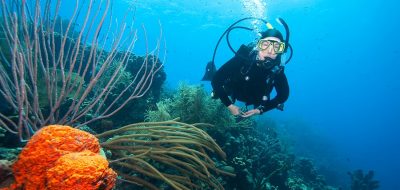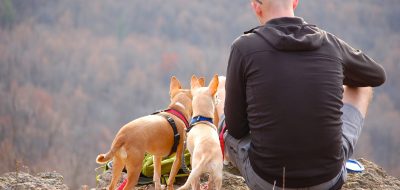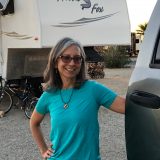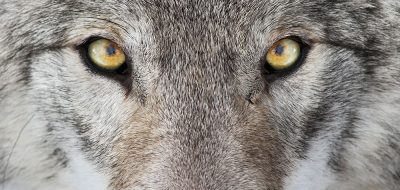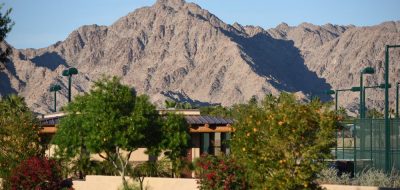 Not all of us will get the chance to go on safari – instead, look around your back yard (or the area around your RV):
Not all of us will get the chance to go on safari – instead, look around your back yard (or the area around your RV):
Although a telephoto lens is useful, and advisable if you are planning to photograph big game, lots of backyard wildlife is waiting for your camera no matter what lens you are using. Although this image of a chipmunk was made in my driveway with a Nikon DSLR with a 70 – 200mm lens, many point & shoot cameras have long enough zoom ranges to make a shot like this. For this picture I set out a couple of grapes, mounted the camera on a tripod about 15′ away & waited. The waiting is the important part whether you are shooting chipmunks or any animal. Until they are comfortable with you they are likely to stay out of sight. Eventually, as long as you appear non-threatening and don’t move around, they will accept the fact that you are there and go about their primary business – eating!


 Sunflower seeds also work well, particularly if you want a “chubby cheeks” shot. You will need to experiment with the size of the pile of sunflower seeds – Too few & you don’t get the chubby cheek look. If the pile is large enough, you will get a short chance to snap a photo as it looks up just before dashing off to deliver the seeds to its hiding place. If the pile is just the right size, the chipmunk will hang around looking for more, giving you a better chance to get the picture.
Sunflower seeds also work well, particularly if you want a “chubby cheeks” shot. You will need to experiment with the size of the pile of sunflower seeds – Too few & you don’t get the chubby cheek look. If the pile is large enough, you will get a short chance to snap a photo as it looks up just before dashing off to deliver the seeds to its hiding place. If the pile is just the right size, the chipmunk will hang around looking for more, giving you a better chance to get the picture.


 There are likely to be many other “backyard wildlife” opportunities. Most point & shoot cameras have macro capabilities. If you have a DSLR, you will need to purchase a macro lens. I have an earlier post on shooting macros. In either case, there are many subjects waiting for you. Some of these samples of macros taken with DSLRs, others with point & shoot cameras. If you want to take the steps in the macro article, extreme close ups are possible, opening a whole new world of images.
There are likely to be many other “backyard wildlife” opportunities. Most point & shoot cameras have macro capabilities. If you have a DSLR, you will need to purchase a macro lens. I have an earlier post on shooting macros. In either case, there are many subjects waiting for you. Some of these samples of macros taken with DSLRs, others with point & shoot cameras. If you want to take the steps in the macro article, extreme close ups are possible, opening a whole new world of images.


 Some other subjects include birds, snakes, frogs, etc. I like to add branches to my bird feeder support so that photographs look more natural. The other images resulted from walking around keeping my eyes open for what ever is running around.
Some other subjects include birds, snakes, frogs, etc. I like to add branches to my bird feeder support so that photographs look more natural. The other images resulted from walking around keeping my eyes open for what ever is running around.
Some general suggestions:
- Using the manual settings for aperture will often give better results than shooting in the program mode. The reason? The wildlife is often “posed” in front of leaves, grass, brush, etc. If you use small apertures the background will be in focus as well as the subject. By selecting a wide aperture (such as f: 2.8) the background will be blurry, isolating your subject. It will also give you a faster shutter speed, useful for fast moving subjects or reducing camera shake.
- Speaking of camera shake, using a tripod will eliminate it. Of course there are many subjects where a tripod won’t work, however if it is possible, use one. Since you will often have to wait long times for your subject to work its way into the picture, hand holding even light cameras gets tiring. If you have a manual remote shutter release, use it. Better yet, if it is available for your camera, a wireless shutter release lets you get out from behind the camera, making the subjects less nervous.
- Although “baiting” is frowned upon for hunting, I have no problem with providing non-living food when shooting photographs. Look up what food the local wildlife likes to eat & set some out, set up your camera & shoot away.
- Fill flash is often useful, particularly in situations where harsh sunlight produces shadows on your subject. If your camera has flash exposure compensation, try setting it 1/3 to 1/2 stop below normal so the lighting still seems natural. You may need to experiment with the settings, but fill flash often improves the image.
- If you have a choice, shoot on overcast days. The diffuse lighting will prevent harsh shadows, although you may need to add some contrast to the photographs with your editor since the soft lighting can flatten the image.
- Spend some time without your camera discovering how & where the various backyard wildlife lives. Once you figure that out you will be far better prepared to determine time of day, camera locations, lenses, etc than if you just go out & start shooting.
- Lastly, one great advantage for RVers is they have a different backyard every time they move! When visiting our National Parks there are great opportunities:


